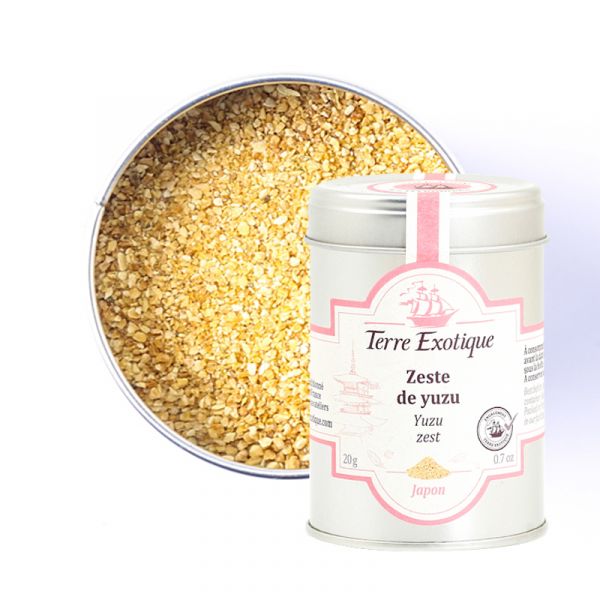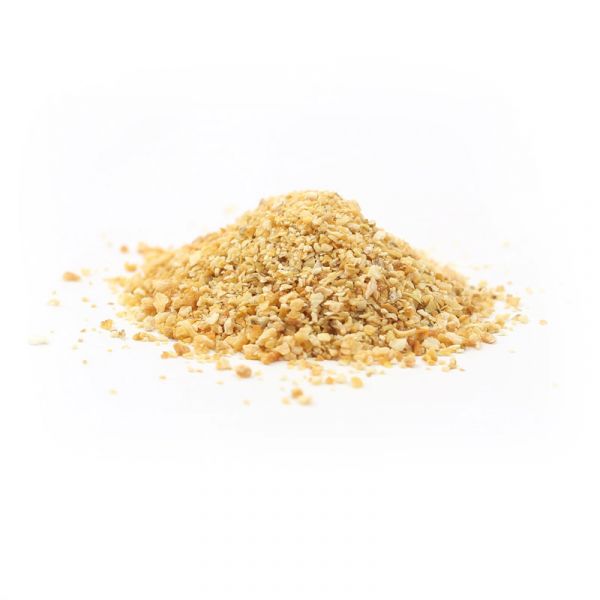





Characteristics of Yuzu, Japanese Citrus Fruit
Yuzu zest originates from Japan. Yuzu, also known as Japanese lemon or Citrus reticulata, is a hybrid of wild mandarin and lemon. This citrus fruit, native to Tibet and China, grows wild. It is a tree of the Rutaceae family, which can grow up to 4 meters tall and withstand temperatures as low as -15°C. Today, it is in Korea and Japan where it is mostly cultivated and used in gastronomy, traditional medicine, as well as in perfumery or cosmetics.
This Japanese fruit, resembling a small lime, is harvested in October in the Koshi prefecture of Japan. Its taste, similar to that of mandarin and yellow grapefruit, pairs well with both sweet and savory dishes, perfect in a sorbet, in sweet potato puree, or even in a chocolate preparation.
Yuzu and Its Powerful Aromas
Yuzu, for Lovers of Tangy and Fruity Flavors
Yuzu has a taste similar to that of mandarin and yellow grapefruit. Both powerful and balanced, it is a condiment full of aromas. It can be consumed in different forms: fresh, in juice, zest, powder, or even pearls. Use it in your savory as well as sweet preparations, Yuzu will flavor all your dishes.
What Dishes to Use Yuzu Zest In?
Both fresh and delicate, Yuzu zest is perfect on roast chicken. Yuzu will enhance your vegetable sautés and soups, as well as your marinades, sauces, or chocolate desserts. Feel free to marinate your fresh salmon sashimi with a teaspoon of Yuzu zest, it will add a lemony flavor to your dish. Yuzu is one of the ingredients in the Japanese Ponzu sauce, made with soy sauce and Yuzu juice. It is also one of the components of the Japanese spice blend, also known as Japanese curry, Shichimi Togarashi, a perfect combination on grilled meat!
For summer, don't hesitate to add Yuzu zest to your vinaigrette to enhance your salads! Pour ½ tablespoon of miso into a bowl, add 3 tablespoons of rice vinegar, 1 teaspoon of Yuzu zest, 5 tablespoons of olive oil, salt, and pepper. Finally, let your creativity shine in your desserts!
Yuzu is perfectly suitable for all sweet preparations. Its tangy taste enhances your preparations and gives character to your creams, whipped cream, muffins, or pies. Yuzu pairs wonderfully with chocolate!
However, be careful with the dosage, Yuzu zest has a very pronounced taste!
How to Use Yuzu in Cooking?
Our recipe ideas to use Yuzu in your cooking:
• Yuzu chicken bites: sprinkle chicken with Yuzu zest and marinate it;
• Cod with Yuzu coriander sauce: add Yuzu zest to melted butter before adding heavy cream;
•Parsnip velouté with Yuzu zest: click here to discover the complete recipe
•Yuzu cream: add Yuzu zest after reducing the cream;
• Lemon tart with Yuzu zest: add Yuzu zest to the lemon cream during preparation;
• Yuzu macarons: add Yuzu zest to the whipped ganache.
Yuzu and Traditions
A Citrus Fruit with Multiple Uses
Yuzu originates from East Asia, particularly from China and Tibet, where it grows wild. It was introduced to Japan during the Tang dynasty around 700 AD. In Japan and Korea, it is used in cooking, but also in traditional medicine, as its properties help to fight fatigue and pain. In Japan, Yuzu is also traditionally infused in baths to soften the skin and fight fatigue thanks to its invigorating effects. In Korea, the wood of the tree in which Yuzu grows is used for making musical instruments such as the taepyeongso.
| Allergen | Absence |
|---|---|
| Native country | JAPON |
| Genus and botanical species | Citrus ichangensis |
| Ingredients | yuzu zest |
| Nutritional Info | VN Energie pour 100 g (energy for 100g) : 1494 kJ / 357 kcal VN Matière grasse (fat) : 1 g Dont acide gras saturés (of which saturated fat) : 0.3 g VN Glucides (carbohydrate) : 81 g Dont sucres (of which sugars) : 61 g VN Protéines (protein) : 5.9 g Vn Sel (salt) : 0.01 g |
| TRACES EVENTUELLES D'ALLERGÈNES | céleri, sésame, moutarde, fruits à coques. |
 Français
Français 
